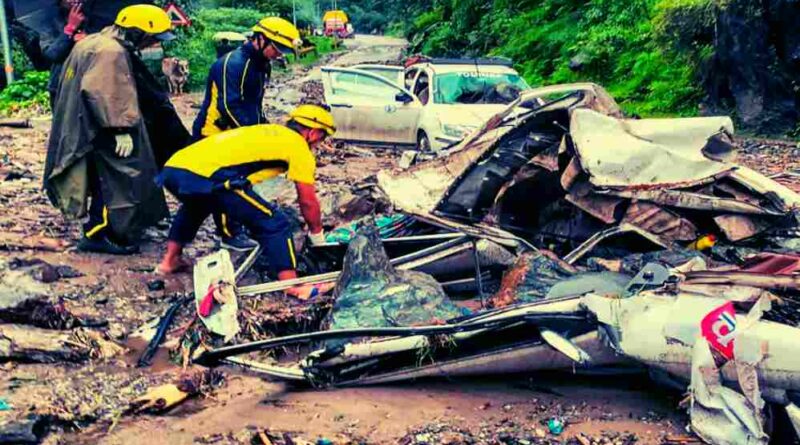Uttarkashi Cloudburst Wreaks Havoc: Market Vanishes in 20 Seconds, Locals Struggle Amid Widespread Destruction
In a terrifying burst of nature’s fury, the serene landscape of Uttarkashi’s Kheerganga turned into a site of devastation within seconds, as a powerful cloudburst triggered a sudden and violent flood. What was once a bustling market zone nestled in the lap of the Himalayas now lies in shambles — broken walls, mangled tin roofs, and the bitter scent of scorched timber fill the air.
Residents say it all happened in a flash. Around 8 PM last night, heavy rainfall that had been looming ominously turned deadly. Within seconds, a furious torrent of water — muddy, debris-laden, and unstoppable — came crashing down from the hills, wiping out everything in its path.
“It took barely 20 seconds,” said Devendra Rawat, a local shopkeeper who had just stepped away from his stall to take shelter. “One moment the market was alive with people, the next it was gone. I saw bikes swept away like toys. I saw walls crumble like sand.”
Night of Chaos
The sudden flood swept through the narrow Kheerganga valley, reducing over a dozen shops and several vehicles to rubble. But it wasn’t just water that tore through the area — eyewitnesses also report hearing loud blasts, followed by plumes of smoke.
“It looked like the sky had cracked open and dropped fire,” shared Meena Thakur, a hotel worker who fled barefoot from the blaze that followed. “We don’t know if it was gas cylinders or something else, but the hotels caught fire almost instantly.”
Several hotels, guesthouses, and residential homes caught fire during or immediately after the flooding, adding to the horror. Visuals from the area show charred buildings, their walls still smoldering, as dazed locals search for missing belongings and loved ones.
The Kheerganga area, often frequented by tourists and trekkers for its spiritual charm and natural beauty, has now become a site of sorrow. What was meant to be a peaceful pilgrimage route turned into a dangerous death trap overnight.
Rescue Underway, But Terrain Is a Challenge
Rescue teams, including local authorities, SDRF personnel, and volunteers, have been deployed since dawn. However, landslides and washed-away roads are making access extremely difficult. Many villagers and tourists are still believed to be trapped or stranded in higher altitudes, waiting for help to reach them.
Officials have confirmed multiple injuries and fear the death toll may rise. Helicopters have been kept on standby, but poor visibility in the mountain region is hampering aerial evacuations.
“We are doing everything we can, but the scale of damage is unlike anything we’ve seen in recent years,” said one rescue official at the base camp. “We are trying to clear paths with machinery, but the mud is waist-deep in some areas.”
A Community in Shock
The people of Uttarkashi are no strangers to nature’s volatility, but this event has left the entire community shaken. Locals who relied on the Kheerganga market for their livelihoods are now staring at nothing but ruins. Hundreds of families are displaced, some with nothing but the clothes on their backs.
Temples and dharamshalas that once echoed with chants and bells are now eerily silent, their courtyards filled with silt and debris.
The emotional toll is visible on every face — from grieving elders to frightened children. Many are mourning not just the loss of property but the erasure of memories tied to the homes and businesses that stood here for generations.
Environmental Alarm Bells Ring Louder
This disaster isn’t just an isolated incident. Experts are once again raising alarms about the region’s fragile ecosystem and the escalating impact of climate change. Unseasonal rainfall, cloudbursts, and extreme weather events are becoming dangerously common across the Himalayan belt.
“The mountains are screaming for help, and we continue to build, dig, and explode in the name of development,” said a local environmentalist. “Disaster after disaster — and we still don’t pause to rethink our choices.”
What Happens Next
Relief camps have been set up in nearby safer areas, with local NGOs and volunteers stepping in to provide food, clothes, and basic medical aid. Still, much more is needed — in terms of both immediate assistance and long-term rehabilitation.
The coming days will be crucial in locating the missing, restoring communication lines, and ensuring that no one is left behind. But for now, Uttarkashi mourns — and prays.
As the monsoon clouds continue to hover, the people of this quiet Himalayan town wait anxiously, hoping that nature will show mercy, and that help will reach before the next drop falls.
Disclaimer
The information and content shared on digitalgithub.com — including articles, blogs, news, guides, and other resources — is intended for general informational and educational purposes only. We do not guarantee the completeness, reliability, or suitability of any information. Always seek the guidance of a qualified professional before making decisions based on the information you read. Use this site at your own risk.

